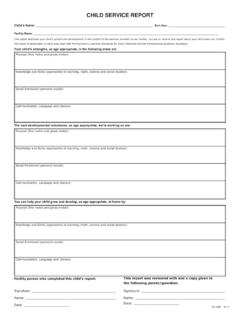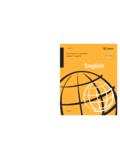Transcription of Te Whāriki
1 Te W h r ik iHe wh riki m tauranga m ng mokopuna o AotearoaEarly childhood curriculumPublished 2017 by the Ministry of Education, New Zealand Te T huhu o te M taurangaM tauranga House, 33 Bowen Street PO Box 1666, Thorndon Wellington 6140, New copyright 2017 ISBN 978-0-478-16926-3 (print)ISBN 978-0-478-16927-0 (online)Replacement copies may be ordered from Ministry of Education Customer Services: Please quote item number 16926 Online Email Freephone 0800 660 662 Freefax 0800 660 663 THE COVER WH RIKIThe cover represents part of the underside of a wh riki or woven mat. The green symbolises new life, growth and potential and references harakeke and pandanus, which are used throughout Te Moana-nui-a-Kiwa as materials for the upper side of a wh riki displays the weaver s artistry it is the underside that reveals their mastery. Expert weavers will examine the foundations for planning and technique.
2 If these are sound, the quality will be seen on the face-up side. A weaver weaves in new strands of harakeke or pandanus as their wh riki expands. This creates a join, called a hiki or a hono. A hono can be seen running down the spine of the book in a darker green. This joining of new material symbolises new learning . When the document is opened at the place where the two parts of the flip book meet, it can be seen that the wh riki is unfinished, with loose strands still to be woven. This acknowledges the child s potential and their ongoing educational wh riki on the cover and the graphic on page 11 were developed by artist and kairaranga (weaver) Mari Ropata-Te Hei (Ng puhi, Ng ti Raukawa ki te Tonga, Te ti Awa me Ng ti Toa Rangatira) and graphic designer Te Iwihoko Rangihirawea (Ng ti Rangi, Ng ti Pikiahuwaewae).The Ministry of Education gratefully acknowledges and thanks the children, their parents and wh nau, and the kaiako, teachers and educators whose photos are used in this publication with W h r ik iHe wh riki m tauranga m ng mokopuna o AotearoaEarly childhood curriculum2Te Wh riki Early childhood curriculumForewordAll children are born with immense potential.
3 Quality early learning helps our children begin to realise that potential and build a strong foundation for later learning and for life. New Zealand s early learning standards are amongst the highest in the world and almost all of our children are participating and benefitting from a rich array of relationships and experiences in our early learning published in 1996, Te Wh riki: He wh riki m tauranga m ng mokopuna o Aotearoa Early childhood curriculum provided a celebrated framework which has shaped our distinct approach to early learning in Aotearoa. 20 years on I am delighted to introduce this revised and refreshed in its bicultural framing, Te Wh riki expresses our vision that all children grow up in New Zealand as competent and confident learners, strong in their identity, language and culture. It emphasises our bicultural foundation, our multicultural present and the shared future we are creating.
4 It encourages all children to learn in their own ways, supported by adults who know them well and have their best interests at vision is expressed in different ways as early learning services work with parents, wh nau and communities to design and implement a programme of learning and development that reflects local priorities and supports each child s personalised learning pathway. The underpinning concept of the wh riki (mat) enables and supports this diversity. I would like to acknowledge the significant contribution of Te K hanga Reo National Trust in supporting the development of the original Te Wh riki, which draws upon traditional M ori concepts underpinning the philosophy of k hanga reo. These concepts were embraced by the wider early learning sector and continue to frame our thinking today. The Trust has also made a strong contribution to this revision, expanding earlier text to become Te Wh riki a te K hanga Reo, a distinct curriculum pathway for mokopuna and their wh nau in k hanga reo.
5 I also acknowledge those members of the early childhood education sector who have provided valued leadership and expertise which has shaped this document for today s world, and for the update reflects changes in the early learning context, including the diversity of New Zealand society today, contemporary theories and pedagogies. It provides clear and empowering learning outcomes, makes explicit links to The New Zealand Curriculum and Te Marautanga o Aotearoa and positions our children as 21st century citizens, learning how to learn in a fast changing and globally connected world. It supports the work of Communities of learning | K hui Ako which bring their collective efforts to enabling the learning success of every child. I am pleased to present this update of a highly regarded and celebrated curriculum and to endorse its equally valued dual pathways.
6 I warmly acknowledge the talents and dedication of the teachers, kaiako and educators, who, together with parents, wh nau and communities, will bring this curriculum to life. Education is the critical cornerstone of lifelong learning and puts our youngest learners on pathways to quality life mauriora!Hon Hekia ParataMinister of EducationHe taonga te mokopuna, kia wh ngaia, kia tipu, kia child is a treasure, to be nurtured, to grow, to flourish. BACK TO CONTENTSTe Wh riki Early childhood curriculum3Te Tiriti o Waitangi The Treaty of WaitangiTe Tiriti o Waitangi | the Treaty of Waitangi is New Zealand s founding document. Signed in 1840 by representatives of M ori and the Crown, this agreement provided the foundation upon which M ori and P keh would build their relationship as citizens of Aotearoa New Zealand. Central to this relationship was a commitment to live together in a spirit of partnership and the acceptance of obligations for participation and protection.
7 Te Tiriti | the Treaty has implications for our education system, particularly in terms of achieving equitable outcomes for M ori and ensuring that te reo M ori not only survives but thrives. Early childhood education has a crucial role to play here, by providing mokopuna with culturally responsive environments that support their learning and by ensuring that they are provided with equitable opportunities to learn. The importance of such provision is underscored throughout Te Wh riki: He wh riki m tauranga m ng mokopuna o Aotearoa Early childhood Zealand is increasingly multicultural. Te Tiriti | the Treaty is seen to be inclusive of all immigrants to New Zealand, whose welcome comes in the context of this partnership. Those working in early childhood education respond to the changing demographic landscape by valuing and supporting the different cultures represented in their settings.
8 E tipu, e rea, mo nga ra o tou ao,ko to ringa ki nga rakau a te Pakehahei ara mo te tinana,ko to ngakau ki nga taonga a o tipuna Maorihei tikitiki mo to mahuna,a ko to wairua ki to Atua,nana nei nga mea Apirana Ngata (1949)11 As per the handwritten original, a copy of which hangs in the library of Ngata Memorial College, Ruatoria (see page 68).BACK TO CONTENTS4Te Wh riki Early childhood curriculumContentsForeword ..2Te Tiriti o Waitangi | The Treaty of Waitangi ..3 Introduction ..6 Early childhood education in New Zealand ..8 The wh riki ..10A curriculum for all children ..12 How the curriculum framework is organised ..16 Principles | Kaupapa whakahaere ..17 Empowerment | Whakamana ..18 Holistic development | Kotahitanga ..19 Family and community | Wh nau | Ng hononga ..21 Strands, goals and learning outcomes | Taumata whakahirahira.
9 22 Overview ..24 Wellbeing | Mana atua ..26 Belonging | Mana whenua ..30 Contribution | Mana tangata ..36 Communication | Mana reo ..41 Exploration | Mana aot roa ..46 Pathways to school and kura ..51 Responsibilities of kaiako ..59 Underpinning theories and approaches ..60 Assessment, planning and evaluation ..63 Glossary of M ori and Pasifika words ..66 References ..68Te Wh riki: Two pathways ..69 BACK TO CONTENTS5 Competent and confident learners and communicators, healthy in mind, body and spirit, secure in their sense of belonging and in the knowledge that they make a valued contribution to societyBack to Contents6Te Wh riki Early childhood curriculum6 INTRODUCTIONTe Wh riki: He wh riki m tauranga m ng mokopuna o Aotearoa Early childhood curriculum (Te Wh riki) sets out the curriculum to be used in New Zealand early childhood education (ECE) settings and provides guidance for its Te Wh riki is the vision that children arecompetent and confident learners and communicators, healthy in mind, body and spirit, secure in their sense of belonging and in the knowledge that they make a valued contribution to purapura i ruia mai i Rangi tea e kore e seed sown in Rangi tea will never be M ori tradition the child was a valued member of the M ori worlds before conception, before birth, and before time.
10 They began their journey in Rangi tea, homeland of the gods. Born into this world, they were nurtured like a precious seed to ensure their survival and inculcated with an understanding of their own (2013) Located in Aotearoa New Zealand, this vision implies a society that recognises M ori as tangata whenua, assumes a shared obligation for protecting M ori language and culture, and ensures that M ori are able to enjoy educational success as M child is on a unique journey. They come into the world eager to learn and into family, wh nau or aiga that have high hopes for them. Teachers, educators and kaiako in ECE settings work together in partnership with the family to realise these See Notice for providers on page TO CONTENTSTe Wh riki Early childhood curriculum7 INTRODUCTIONThe expectation is that, in their early years, children will experience a curriculum that empowers them for their journey.



